
|
Sale 51
Pre-Long Beach Coin and Currency Auction
| Lot |
Photo |
Description |
Realized |
Lot 1035 |
 |
1794 Flowing Hair Dollar. . BB-1, B-1. PCGS graded EF-40. Well struck for this famous issue with plenty of hair detail and a nice full date. Lightly toned. An excellent example of this rare date that boasts light antique silver-gray color and defect-free surfaces. The obligatory adjustment marks are randomly located about the upper and upper left reverse margin and are generally unobtrusive, with the heaviest over STA of STATES; none through the eagle or wreath, which is very positive. The surfaces show minor circulation hairlines, and both sides have a remarkable freedom from surface marks and certainly no rim bruises. For a 1794 dollar in EF40, this one is well struck, with all the stars visible, a complete date, and all of the reverse lettering is present, but weak due to the strike and the adjustment marks. Liberty's hair retains good separation on all but the uppermost wave over her ear, which shows the expected wear. Other identifying features are a small nick below the 4 in date. Very few graded at this level to date (see below).
The 1794 dollars were coined on October 15, 1794 from silver bullion deposited by David Rittenhouse, and all were coined on this date and delivered to David Rittenhouse (according to Breen and Collins in their 1794 silver dollar research). Thus, all 1794 silver dollars can trace their pedigree to David Rittenhouse, who passed them out to friends, many of whom kept them, others were spent and circulated.
The 1794 silver dollar is an American classic. It is the first year of issue of the national monetary Unit, and was struck in extremely limited quantities, with the total known population causing it to be a very expensive proposition for all but the wealthiest coin collectors. Population 10; 15 finer at PCGS.
Estimated Value $200,000 - 225,000.
View details and enlarged photos
| Unsold |
Lot 1036 |
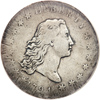 |
1794 Flowing Hair Dollar. . BB-1, B-1. PCGS graded VF-20. An above average strike on a decent planchet with some weakness around the borders. We note some adjustment marks about the obverse borders as made. Light antique grayish toning that deepens about the recesses and borders. Always in great demand.
The Philadelphia Mint did not have a coining press brawny enough to strike dollar-size coins in 1794, the largest one being used for large cents and half dollars. Therefore, this half dollar press was employed to strike the first American silver dollars. Compromises had to be made. It was soon revealed that the press could not fully strike the design on the left side of the coin (the dies being slightly misaligned). Although the left hand stars and upper portion of the left side reverse letters are normally weakly impressed, they are completely visible to the naked eye.
Few coins command such reverence in the numismatic community as a 1794 Flowing hair silver dollar, a classic in any grade. Only 1,758 pieces were coined in the autumn of 1794, each delivered to David Rittenhouse personally, as it was he who put up the bullion to create the entire mintage of our first U.S. dollar coins. Of the original mintage, only 125 to 150 pieces are believed to survive in all grades, mostly worn or showing various damage. Adjustment marks are evident on nearly all. Two authors, Jack Collins and Martin Logies, have devoted book-length studies of this one issue, and each and every specimen brought to auction finds an active following.
This example shows central sharpness for the issue, with a clear date, definition in the hair and profile, and even wear on the highpoints. As usual, the left side of both obverse and reverse are more softly impressed than elsewhere, but star 1 (and the other stars in the region) are completely visible as is the top half of the 1 in the date. Due to extensive adjustment around the obverse rim, UNITED STATES is legible though softly defined at the tops of the letters. The color is a light gray with dark gray areas above UNITED. Some vague vestiges of long ago cleaning are noted, no obvious scratches or rim problems and only light scattered marks (PCGS # 6851) .
Estimated Value $120,000 - 130,000.
View details and enlarged photos
Check results on similar lots
| Unsold |
Lot 1037 |
 |
1794 Flowing Hair Dollar. . BB-1, B-1. NGC graded Fine-15. A very pleasing example for the grade with a nice full date and free from defects and major flaws. We note some normal weakness about the left side stars and corresponding portions on the reverse. A nice even light lilac-grey tone further enhances its appearance. Always in great demand as our regular First Silver Dollar.
Historic note: The dies for the 1794 dollar are almost certainly the work of Robert Scot, a medalist and die sinker. On November 23, 1793, Secretary of State Thomas Jefferson, who was in charge of the affairs of the Mint, wrote to Robert Scot and sent him a commission to be engraver at the Mint. To Scot fell the task of cutting the dies for coinage, including the 1794 Flowing Hair dollar. In November 1794, John Smith Gardner was hired as his assistant, but by this time the initial delivery of silver dollars had been accomplished. Probably, Gardner worked on some of the 1795 and later dies.
To prevent filing and clipping by the public to reduce a minted coin's weight, it was desired to ornament the edge. In this way, the removal of silver could be detected. For the silver dollar, lettering was applied by a machine which rolled the finished planchet (but before striking by the dies) between two parallel steel bars, upon each of which was half of the edge lettering inscription: HUNDRED CENTS ONE DOLLAR OR UNIT and ornamentation between words.
Per the Bowers encyclopedia: "Known silver dollars dated 1794 are from a single pair of dies and are believed to have been made to the extent of, perhaps, 2,000 coins (Walter H. Breen's estimate), of which 1,758 pieces were considered to be satisfactory delivered by the coiner on October 15, 1794. The remaining impressions, possibly amounting to 242 coins, rejected as being too weak, probably were kept on hand for later use as planchets. Supporting this theory is the existence of at least one 1795 silver dollar (BB-14) plainly overstruck on a 1794 dollar."
Estimated Value $100,000 - 110,000.
View details and enlarged photos
| Unsold |
Lot 1038 |
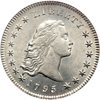 |
1795 Flowing Hair Dollar. Rarity 3. NGC graded MS-64. A brilliant untoned frosty white mint example. Some softeness in the centers as made on a problem free planchet.
Flowing hair in six prominent curls with the lowest curl pierced and separated by the innermost point of star 1, and the curl is continued upwards to almost close its loop. Wide date, the 95 closer together than the other figures. This obverse occurs on BB-19 and BB-20. The reverse has two leaves under each wing. A leaf ends directly below center of first S in STATES and another leaf ends just under left corner of upright of E in STATES. The wreath is delicate, leaves small, berries large. 19 berries arranged nine left, 10 right.
The Flowing Hair design was used on silver coinage in 1794 and 1795. The design is found on half dimes, half dollars, and silver dollars and displays a youthful Liberty facing right with free-flowing hair. (The subsequent Type would have a hair ribbon at the back.)
Since the Coinage Act of 1792 which established the standards for America's coinage has as its centerpiece the silver dollar, the edge lettering on these reads HUNDRED CENTS ONE DOLLAR OR UNIT. The value exists nowhere else on the coin.
Between spring and late summer that year, 17 die marriages of 1795 flowing hair dollars were prepared and used to strike silver dollars. Employed were two bust punches, two separate wreath punches, and two different eagle punches. The mint struck a fairly large number of dollars in 1795: 160,295 to be exact, of which several thousand (according to the Bowers reference book on bust dollars) are believe to survive.
The present specimen is remarkable for its fresh color and frosty surfaces on both sides. It sits squarely atop the assigned grade classification and has lovely silvery brightness. Any marks are held to a minimum. Better still, there appear to be no adjustment lines on either side, a noteworthy observation which qualifies for special mention. The satiny surfaces are aglow with silvery color, devices sharper than on some, but lacking completeness on the eagle's wings and chest feathers, which, as often occurs, is softly brought up. High grade flowing hair silver dollars are the dominant theme among serious, advanced early dollar collectors, with comparatively few Mint States sold in any calendar year. Bowers (1993) estimated only four to six pieces remain in MS64 or better grades. Look for this beautiful MS64 coin to realize a strong price after much spirited bidding. Pop 1, finest graded 2 leaves at NGC. The NGC population also breaks down the various varities and reports two BB-20 examples in 65.
Estimated Value $200,000 - 225,000.
View details and enlarged photos
| Unsold |
Lot 1039 |
 |
1795 Flowing Hair Dollar. Rarity 1. NGC graded MS-64. Well struck and problem free. The lovely smooth planchet shimmers with luster and vibrant sunset colors favoring hues of soft violet and deep blue. This very pretty and well-preserved specimen of a common variety lies near the apex of the Condition Census for the variety. It is an ideal flowing Hair dollar for a Type collector. Deep with the above-mentioned attractive toning, the original luster spreads widely over both sides, the obverse dominated by absolutely exquisite surface quality while the reverse is just about as pristine. The reverse has an identifiable small surface depression (as though a flake of metal escaped during the minting process) that left a shallow void above the eagle's head. The cartwheel luster is very impressive. An exceptional strike is noted throughout, with the often weak breast feathers showing many individual outlines. The most recognizable aspect of BB-27 is a raised line some call a "die bar" common to all BB-27s and visible at the back of Liberty's hair at the top curl. A Type buyer with sophistication and discernment, someone like our consignor, would be fortunate in the extreme to have this specimen in his Type set.
Variety Notes: BB-27 represents one of several varieties with the three-leaves reverse and the Head of '95 obverse. In this case, the portrait of Liberty is in a high-relief rendering on the finished coins. On the obverse, Liberty's lowest curl is open and distant from star one. The reverse displays 13 berries on the wreath, seven on the left branch and six on the right, with three berries beneath the eagle's wing on the left and two berries beneath the wing on the right. Pop 11; 2 in 65 for the 3 leaf variety. The detailed population report listed by die varities shows one BB-27 in 66 as finest for the variety.
Estimated Value $200,000 - 225,000.
View details and enlarged photos
| Unsold |
Lot 1040 |
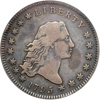 |
1795 Flowing Hair $1 B-3, BB-11 Silver Plug 2 Leaves. Rarity 5. PCGS graded VF-20. Nice even wear with the fields alternating between medium silver-gray to deeper shades, while the highest points of Liberty and the eagle contrast with lighter gray accents. The smooth surface is evident at once. The plug is quite noticeable in the central region around and below Liberty's ear and on the juncture of the right wing of the eagle and it's body.
Adjustment marks and even silver plugs were used to make early silver dollars conform to weight specifications. Each coin was hand-weighed before being released to the Treasury department or to the respective depositor. How the coins appeared was a matter of considerable experimentation in the first few years and was a process that continued until the Gobrecht design was adopted and modified in 1836-39. This is the first style with a large head of Liberty whose hair streams back in flowing waves. Pop 1; 1 finer in 55. Only 2 examples graded for this silver plug variety at PCGS (PCGS # 39990) .
Two leaves under each wing. The only variety with 16 berries, eight on each branch of wreath. There are only two berries on left branch, between eagle's wing and ribbon bow, both on inside of wreath. Reverse die used to strike 1795 BB-11 only. The Bowers encyclopedia estimates that between 50 and 75 1795 BB-11 dollars exist, making this one of the more elusive issues of the Flowing Hair type.
Estimated Value $10,000 - 12,000.
Ex; Hesselgesser Collection.
View details and enlarged photos
Check results on similar lots
| Realized
$17,250 |
Lot 1041 |
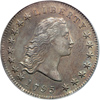 |
1795 Flowing Hair Dollar. 2 leaves beneath each wing. Rarity 2. PCGS graded AU-53. Exceptional beauty and clear hair definition due to fact the head of Liberty was punched deeply into the die. One of the handsomer varieties for a Type buyer who wants a particularly appealing coin. The surface is smooth and almost entirely free of marks (there is a light diagonal mark below the 8th star). Color is somewhat variegated with light to medium shades of silver-gray and pale russet predominating. On the reverse, the well-positioned eagle displays some breast feather detail as well as having a complete eye and nasal opening -- all of which point to a full strike by the dies. Scarce in this higher grade, as the numbers indicate: Pop 1; 2 finer; 1 in 55; 1 in 58. Only 8 examples graded for the variety at PCGS. (PCGS # 39986) .
New head punch (Obverse 6) which differs slightly from BB-20 and before. Flowing hair in five prominent curls, with a thin faint additional curl below the third curl from the top. Innermost point of star 1 just touches lowest curl. The curl continues upward to half close the loop. Head high and closer to LIBERTY than on most other obverses. The date is wide, with more space between 1 and 7 than other figures. The 7 in the date was repunched over an erroneous 1, prompting some to catalogue the variety as 1795 over 1195. As is the case with Obverse 9 used to coin BB-27, the present obverse (also used to coin BB-22 and BB-23) had the head of Miss Liberty deeply impressed into the die, causing it to be in slightly higher relief than most other varieties of the year.
Estimated Value $20,000 - 22,000.
Ex; Hesselgesser Collection.
View details and enlarged photos
Check results on similar lots
| Unsold |
Lot 1042 |
 |
1795 Flowing Hair $1 B-2, BB-20 2 Leaves. Rarity 3. PCGS graded VF-35. A wonderful toned example of the variety, with lighter "rubbed" accents on the highest points while deeper overal silvery gray marks a consistency throughout the field and around devices. The rims are full and crisp, without any bruises or planchet cracks. A Redbook variety, two thin leaves extend downards on each side of the branch at top, above the eagle's head and wing. The leaves as well as the berries and lettering were all punched into the dies by hand in this period, hence the wide variety of berry counts and letter positioning. A fascinating subject for the numismatist. Bust dollar collecting by die variety has been a popular pastime among advanced numismatists for almost 150 years now! Not considered rare as a variety, but: Only two examples graded in VF for this variety at PCGS. (PCGS # 39985) .
Design features the second style head punch Head of 1795. Flowing hair in six prominent curls. The lowest curl is pierced and separated by the innermost point of star 1, and the curl is continued upwards to almost close its loop. Wide date on BB-20, the 95 closer together than the other figures. The upper left star is 2 mm. distant from L in LIBERTY, and is farther from the L than in any other variety. A diagonal "bar," actually a small die scratch, slightly more than 1.5 mm. long appears raised in the left field close to inner point of 4th star, this bar extending diagonally northwest to southeast. The position of the bar distinguishes it from BB-27, which also has a bar, but close to the 5th star.
Estimated Value $9,000 - 10,000.
Ex; Hesselgesser Collection.
View details and enlarged photos
Check results on similar lots
| Unsold |
Lot 1043 |
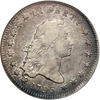 |
1795 Flowing Hair $1 B-9, BB-13 2 Leaves. Rarity 4. PCGS graded VF-30. Light to medium gray patina with the deepest saturation around the lower obverse rim. The reverse is one stage lighter in overall color. Three short parallel marks in the field below Liberty's chin will serve to identify this handsome, lightly circulated coin. Rims are choice; central devices nicely detailed. Despite Bower's estimation of the variety's rarity, the PCGS census is clearly very low. Perhaps others will be encapsulated in years to come, but for now (December 2008): Pop 1; 1 finer in 55. Only 2 examples graded for this variety at PCGS. (PCGS # 39980) .
Two leaves under each wing. 17 berries, nine on left branch, eight on right. A berry is on outside of the wreath midway between S and T of STATES, the only variety in which this occurs; the arrangement is similar to that used on the 1794 dollar. Reverse die used to strike 1795 BB-13 and BB-14. In the years since Bolender suggested a rarity rating of R-5 (31 to 75 coins, if he meant R-5 on the Sheldon Scale), or the 1881 Type-Table designation of "very rare", more specimens have come to light. Bowers now puts the possible census between 300 and 500 pieces.
Estimated Value $8,000 - 9,000.
Ex; Hesselgesser Collection.
View details and enlarged photos
Check results on similar lots
| Unsold |
Lot 1044 |
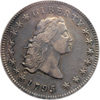 |
1795 Flowing Hair $1 B-5, BB-27 3 leaves. Rarity 1. PCGS graded AU-50. Only a faint trace of adjustment through the lower body of the eagle. Choice, full rims with complete dentils. Desirable Redbook variety in having 3 leaves at the wreath ends instead of 2. A very carefully preserved AU50 example with the most advantageous features for a collector to admire. Its high degree of natural medium gray patina spreads widely beneath smooth, problem-free fields and over equally choice devices. Nicely struck, too, with just a outstanding detail at the usual Achilles' heel on the hair waves. Pop 4; 4 finer. 11 examples graded for this variety at PCGS. (PCGS # 39977) .
A distinctive variety. Flowing hair in six curls, the 3rd and 4th close together; the 4th has a tiny curved "tail" extending downward, and visible on higher grade pieces. Lowest curl distant from star. A "bar" over 2 mm. long extends diagonally from close to top curl toward point of 5th star. Look for the "bar" near uppermost curl. Wide date, the 1 and 7 farthest apart. First star about as close to 1 as 7 is to 9. "As is the case with the obverse die used to coin BB-21, BB-22, and BB-23, the present obverse had the head of Miss Liberty deeply impressed into the die, causing it to be in slightly higher relief than other varieties of the year," explains the Bowers reference on Flowing Hair bust dollars. This obverse die used to strike 1795 BB-27 only.
Estimated Value $17,000 - 18,000.
Ex; Hesselgesser Collection.
View details and enlarged photos
Check results on similar lots
| Unsold |
Lot 1045 |
 |
1795 Flowing Hair Dollar. 3 leaves beneath each wing. . BB-27, B-5. Sharpness of Fine-15. Cleaned with light marks on the reverse. Problem-free rims and nice detail for the grade. On BB-27, the flowing hair in six curls, the 3rd and 4th close together; the 4th has a tiny curved "tail" extending downward, and visible on higher grade pieces. Lowest curl distant from star. A "bar" over 2 mm. long extends diagonally from close to top curl toward point of 5th star and this is diagnostic.
Estimated Value $1,900 - 2,000.
View details and enlarged photos
| Realized
$2,013 |
Lot 1046 |
 |
1795 Draped Bust $1 B-14, BB-51 O/C Dr. Bust. Rarity 2. PCGS graded AU-55. Some shallow adjustment lins diagonally through the eagle's legs and faintly visible at the rims flanking this area. A nicely toned example in this high-end AU55 grade, and one of the finest order. Medium gray toning graces the faint champagne russet traces on what are exceptionally choice surfaces. Sharply struck for the date, as always, easily finer in sharpness than the Centered Head variety this year. Pop 9; 14 finer. (PCGS # 96858) .
Liberty facing right as before, the hair tied up in a ribbon at back. Transitional design featuring a Draped Bust. The bust was not properly centered in the die work, being placed too far to the left. The highest wave of the hair is under the B of Liberty. Lowest curl is distant from 1 in 1795. Star 1 touches curl. This obverse die used to strike 1795 BB-51 only.
For Reverse K the mint introduced a much smaller "Small Eagle," than before, differently styled than on any of the preceding varieties. Small Letters in legend. The eagle stands on clouds. The new wreath is composed of a palm branch (right) and olive branch (left), the latter with seven berries. A short, prominent die scratch extends up to left from tip of right, inside leaf below (observer's) left wing. Berry under A of STATES; a quick way to identify this reverse.
According to Bowers: "This reverse die is one of the most remarkable in all of American numismatics, and was mated with obverse dies bearing four different dates. The features are cut in shallow relief, and the rim is low." All impressions from the die appear somewhat flat, though the shallow relief does not materially affect the appearance of higher grade coins, which often have exquisite detail like the present example, including a full complement of eagle feathers.
Estimated Value $20,000 - 25,000.
Ex; Hesselgesser Collection.
View details and enlarged photos
Check results on similar lots
| Unsold |
Lot 1047 |
 |
1795 Draped Bust $1 B-15, BB-52 Dr Bust. Rarity 2. PCGS graded AU-50. Mildly variegated toning whose color ranges from light silvery around the stars, date, legends and devices to uniform smoke-gray with deeper grays, the underlying surface being exceptionally smooth and mark-free. The choice quality of the coin points directly to our consignor's intense interest in "cherry picking" only the most attractive Bust Dollars for his collection -- and it shows! What's more, PCGS has graded a relatively few examples of the BB-52 Centered Draped Bust Type in upper echelons: Pop 1; 3 finer; 1 in 55; 2 in 58. Only 8 examples graded for the variety at PCGS. (PCGS # 39995) .
BB-52 is considerably rarer than BB-51 in AU and Mint State categories. The population of 1795 BB-52 is, perhaps, about two-thirds that of BB-51, but this means that enough exist that just about any motivated collector can, given a reasonable amount of careful searching, obtain one. As is the case with BB-51, most specimens of BB-52 are in the middle circulated grades. Lower grade coins are seldom seen, and pieces in above Extremely Fine 40 are rare as well.
As in the present instance, most examples are reasonably well centered, with sharp details in all areas. Adjustment marks are seen much less often on specimens of BB-52, probably because the striking was better.
It is interesting to note that the obverse die for BB-51, thought to have been struck in larger quantities than BB-52, is known only in a perfect state, while the BB-52 deteriorated almost from the time it was first used. A noticeable die break occurs in Liberty's hair. Similarly, the reverse used to coin the more plentiful BB-51 was not damaged in the process, and went on to be mated in later years with five other obverses; in contrast, the reverse die of BB-52 developed cracks. The difference in durability undoubtedly was caused by better hardening or tempering of the steel in the BB-51 dies.
Estimated Value $14,000 - 15,000.
Ex; Hesselgesser Collection.
View details and enlarged photos
Check results on similar lots
| Realized
$15,525 |
Lot 1048 |
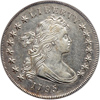 |
1795 Draped Bust $1 B-15, BB-52. Rarity 2. PCGS graded EF-45. Mostly untoned with nice sharp details. A satiny still lustrous specimen with strong underlying luster in and around the main devices. Well struck, in fact fully so -- definitely the quality that rates full mention in this often problematic Small Eagle coinage. Indeed, the strike of the present BB-52 easily rivals that of a higher grade specimen. We note a few light adjustment marks across the eagle's breast. Pop 42 (PCGS # 6858) .
Estimated Value $9,500 - 10,000.
Ex: Hesselgesser Collection.
View details and enlarged photos
Check results on similar lots
| Realized
$12,650 |
Lot 1049 |
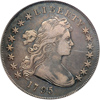 |
1795 Draped Bust Dollar. Centered bust. Rarity 2. PCGS graded VF-30 CAC Approved. A pleasing problem-free example with attractive original antique toning. There are two varieties known of the 1795 draped bust, small eagle. This, BB-52, has the head of Liberty properly centered in the field; the other has the head off-center at the left. Always desirable in choice condition like this. In an old green holder. Pop 70 (PCGS # 6858) .
Estimated Value $6,700 - 7,000.
View details and enlarged photos
Check results on similar lots
| Unsold |
Lot 1050 |
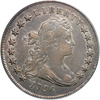 |
1796 Draped Bust $1 B-1, BB-66 Small date, small letters. Rarity 4. PCGS graded EF-40. A few light horizontal adjustment lines through the central reverse. Lustrous around some of the stars and letters of the legend, pleasing choice neutral pewter-gray to "antique silver" colored surfaces put on a show with their lack of marks, planchet defects, or other objections; in truth, the overall appearance greatly reinforced by the choice preservation. Regarding this variety, the date is small date; the 9 and 6 closer together than other figures. The highest wave of hair under upright of E; second highest wave under and slightly to the right of the middle of R. This obverse bears a close resemblance with that of BB-63, and specimens are often confused with it. This and the obverse die used to strike BB-61 and BB-62 were the first two obverse dies cut in 1796, and have the lower right tip of the R in LIBERTY intact. Reverse B, held over from 1795 BB-51, herewith repeated. In fact, this sturdy Small Letters reverse die appeared in no fewer than five marriages: 1795 BB-51; 1796 BB-62, BB-63, and BB-66 (now relapped); 1797 BB-72; and 1798 BB-81. Pop 1; 1 finer in 58. Only 2 examples graded for the variety at PCGS. (PCGS # 39999) .
Estimated Value $9,000 - 10,000.
Ex; Hesselgesser Collection.
View details and enlarged photos
Check results on similar lots
| Realized
$9,488 |
Lot 1051 |
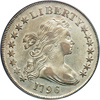 |
1796 Draped Bust $1 B-5, BB-65 Large date, small letters. Rarity 4. PCGS graded AU-55. A bright and light silvery colored specimen whose smooth surface luster seems poised to draw in numerous bids from appreciative bidders, plus we find a touch of slightly deeper toning on the highest wear points, especially on the reverse. The coin clearly did not circulate for long. Well struck on the obverse; adequately struck on the reverse, which is typical, with still outstanding details on both sides. Definitely worth considering. Note also the very low census: Pop 3; none finer at PCGS for the variety. (PCGS # 40002) .
The estimated mintage of 75,000 1796-dated dollars (of various die varieties combined, each of the Draped Bust type) is less than that of the estimated mintage of 110,000 Draped Bust dollars coined with the date 1795. As some numismatic scholars have observed, it may have been the case, indeed likely, that many if not most 1796-dated pieces were struck later, in 1798. "Much of the calendar year mintage of 75,212 dollars struck in 1796 were probably dated 1795," explains the Bowers encyclopedia. "I believe that mintage during the first part of calendar year 1798 consisted in large part of dollars dated 1795, 1796, and 1797."
The Mint experienced various difficulties in 1796, including a yellow fever epidemic. On June 1, 1796, Tennessee was admitted to the Union as the 16th state. While other denominations reflected this, 16 stars were not used on silver dollars until 1797, which suggests that obverse dies for 1796-dated dollars were made prior to June of that year. The number of dies employed to create 1796-dated dollars is as follows: 1796 obverses, 4; 1796 reverses, 4 (includes one left over from 1795).
Estimated Value $25,000 - 30,000.
Ex; Hesselgesser Collection.
View details and enlarged photos
Check results on similar lots
| Unsold |
Lot 1052 |
 |
1796 Draped Bust $1 B-5 BB-65 Large date, small letters. NGC graded EF-45 Rarity 4. Lightly even toning. Highly attractive and largely wide dentils acting to frame the inner features, and displaying light to medium gray highlights over both sides. All but fully struck, which is very unusual in a 1796 Draped Bust, Small Eagle dollar, with just a little insubstantial touch of weakness at the eagle's breast and leg feathers. Rims are choice. The entire appearance is one of careful preservation. Note the die break at IC of AMERICA. This is a distinguishing feature of this reverse die which has small letters in UNITED STATES OF AMERICA. Pop 9; 6 finer; 1 in 50; 2 in 55; 1 in 58; 1 in 61; 1 in 63.
Estimated Value $9,500 - 10,000.
View details and enlarged photos
| Unsold |
Lot 1053 |
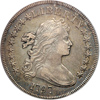 |
1797 Draped Bust $1 B-2, BB-72 9X7 Stars, small letters. Rarity 4. PCGS graded EF-45. Wide dentils on this specimen act as a frame for the inner design. While lower-end circulated examples are occasionally available, looking through the auction results over the years show us Efs are surprisingly elusive. This is a carefully graded, lightly patinated survivor that is indicative of an even higher grade because of the extra-choice surfaces and balanced appearance. Rims are problem-free. Fields are too. And the all-important aesthetic appeal is intact. Pop 2; None finer at PCGS for the variety. (PCGS # 40005) .
In the words of the Bowers encyclopedia of Silver Dollars, "of all 1797 varieties, the BB-72 is at once the rarest, best known, and most sought after. This issue occupies its own niche in numismatic literature, where it has been showcased as a rarity in some instances and ignored in others. Doubtless, it is the best known die variety of the 1796-1797 years combined. Indeed, it may well be the most famous variety after 1794 and before 1804.
"While various cataloguers over the years have ascribed great rarity to 1797 BB-72, I believe that about 200 to 300 exist today, as explained in detail above."
Estimated Value $18,000 - 22,000.
Ex; Hesselgesser Collection.
View details and enlarged photos
Check results on similar lots
| Realized
$29,900 |
Lot 1054 |
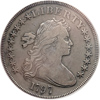 |
1797 Draped Bust Dollar. 9 stars left, 7 right, small letters. PCGS graded VF-25. Well struck with lots of detail for the VF-25 grade. Struck on a problem free planchet and all overlaid with uniform antique grayish toning. On this key variety, the 16 stars are arranged 9 to the left and 7 to the right. The highest wave of hair, below upright of E, is lightly defined, probably due to insufficient depth of punching of the Draped Bust motif into the die (and not due to relapping). There is a prominent die-caused lump in field below star 9. Heavy die file lines in front of neck. One is vertical with several others slanting down to right. This obverse die was used to strike 1797 BB-72 (earlier) and BB-73 (later).
The reverse is the same used on 1795 BB-51 with Small Eagle. Small Letters in legend. The eagle stands on clouds; to the sides, the wreath is composed of a palm branch (right) and olive branch (left), the latter with seven berries. A short, prominent die scratch extends up to left from tip of right, inside leaf below (observer's) left wing. Berry under A of STATES; a quick way to identify this reverse. This workhorse reverse was used to strike 1795 BB-51; 1796 BB-62, BB-43, and BB-46 (now relapped); 1797 BB-72; and 1798 BB-81.
How many exist? 1797 BB-72 has been the subject of widely varying estimates of rarity over the years, with some observers stating that as few as 20 are known, while others rank the population at Sheldon's Rarity-4 (76 to 200). The latter seems to be closer to the truth (PCGS # 6866) .
Estimated Value $7,500 - 8,500.
View details and enlarged photos
Check results on similar lots
| Realized
$6,900 |
Lot 1055 |
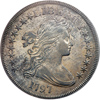 |
1797Draped Bust $1 B-1, BB-73 9X7 Stars, large letters. Rarity 3. PCGS graded EF-40. Well detailed for this more BB-73 variety, a low survival variety, with soft golden-brown to dappled steel accents that improve the appeal of this nearly EF45 specimen. The rims, the fields, the devices, on both sides are problem free. The appeal of this coin is its 9x7 star arrangement along with Large Letters in the reverse legend.
The 1797 BB-73 dollar is usually seen with broad borders, a feature particularly noticeable on the obverse, where the dentils are prominently featured, but also to an extent on the reverse. The reverse is usually not as well defined as the obverse, due to the relatively low relief of the small-eagle motif. However, the breast feathers and other reverse details are usually there in higher grade specimens of earlier die states. Together with BB-71, the BB-73 is one of the two most available varieties of the year; both BB-73 and BB-71 are much more plentiful than BB-72. Pop 1; 8 finer; 3 in 45; 4 in 55; 1 in 58. Only 11 examples graded for the variety at PCGS. (PCGS # 40003) .
A note to buyers of Draped Bust, Small Eagle coins, when Jim Ruddy was assembling the 5,000+ photographs he need to produce "Photograde", the official grading guide, back in the late-1960s and early 1970s, he commented time and again to all his friends in the business just how troublesome it was to find attractive, photogenic examples of this short-lived style used on everything from half dimes all the way through silver dollars. To this day, it is our observation as well that the Draped Bust, Small Eagle coins are consistently the most difficult to acquire in choice, problem-free condition. So take heart at the extensive advantage of the Dr. Hesselgesser collection.
Estimated Value $9,000 - 10,000.
Ex; Hesselgesser Collection.
View details and enlarged photos
Check results on similar lots
| Realized
$9,775 |
Lot 1056 |
 |
1797 Draped Bust $1 B-3, BB-71 10X6 Stars. Rarity 2. PCGS graded EF-45. A sleek golden smoky gray example with a luxurious display of smooth surfaces and balanced hues on both sides. Nicely socked by the dies, perhaps not fully so at the central part of Liberty's head, but still well enough that its attraction is enhanced. The 1797 issues have proved popular with collectors since the earliest days. This is partly due to their putative low mintage, and also because they vary a lot in appearance and width of planchet from one variety to the next.
In 1797 the number of stars on the silver dollar was increased to 16. The coinage is said by government reports to be the lowest of any year from 1795 to 1803, although now it is believed that the numbers given are incorrect. I believe that most or all of the mintage of 7,776 coins reported for the calendar year may have been of earlier dates, and that most coins struck from dies dated 1797 were actually made in early 1798.
"It is a virtual certainty that many more than 7,776 silver dollars were struck with the 1797 date," explains Bowers. "I estimate the number to be 60,000…" Many hold the position that the 1797 must have been about on a par with that of 1796, or not significantly different, given the number known today. As the estimated 60,000 1797-dated silver dollars could not have been struck earlier than 1797, and the quantity made is almost certainly far greater than 7,776, the only remaining possibility is that they were struck later, with the calendar year 1798 being the most likely candidate.
In 1797, production problems continued at the Mint. Sporadic coinage runs for silver dollars occurred in February, late May to late June, and in August. The Mint was closed from late August to late November, due to a yellow fever outbreak. Thus, the mintage for the calendar year was very small. Pop 4; 2 finer; 1 in 55; 1 in 58. Only 9 examples graded for the variety at PCGS. (PCGS # 40004) .
Estimated Value $12,000 - 13,000.
Ex; Hesselgesser Collection.
View details and enlarged photos
Check results on similar lots
| Unsold |
Lot 1057 |
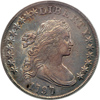 |
1797 Draped Bust $1 B3, BB-71 10X6 Stars. Rarity 2. PCGS graded EF-40. A sharp-quality example of the premium quality one likes in Dr. Hesselgesser's collection, something very positive to say for this actively collected design. Swirling bands of steel to iridescent color blend naturally with pale golden russet-lavender highlights on the choice surfaces. Just about fully struck, with just a dash of weakness at the centers, as almost always seen. Pop 2; 6 finer; 4 in 45; 1 in 55; 1 in 58. Only 9 examples graded for the variety @ PCGS. (PCGS # 40004) .
No other use of either obverse or reverse die is known. On the obverse, 16 stars, only six at right facing bust. A die dot close to the bottom right of the second digit makes the date read 17.97 (some imagination is required); the last 7 is high. The star arrangement of 10 stars to the left and six to the right is unique in the dollar series. Obverse die used to strike 1797 BB-71 only.
Reverse A: Large letters in legend. 8 berries in left branch. Leaf ends under middle of E in STATES. Lowest berry near ribbon bow is on outside of wreath. Large planchet. A leaf is almost below the T in UNITED, a berry is under the center of the first T in STATES, another leaf is past the O in OF and another leaf is very close to the R in AMERICA. Three leaves below eagle's right (observer's left) wing. Reverse die used to strike 1797 BB-71 only.
Estimated Value $11,000 - 12,000.
Ex; Hesselgesser Collection.
View details and enlarged photos
Check results on similar lots
| Unsold |
Lot 1058 |
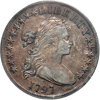 |
1797 Draped Bust $1 B-3, BB-71. Rarity 2. PCGS graded VF-30 PQ. Nice old time toning. The shades variegated with russet brown to mid-level "antique" gray hues predominant over both sides. A few light abrasions in the fields, though generally sharper appearing than your average VF30 example of this variety, and so we give it a "PQ" ranking.
So little silver bullion was being deposited in 1797 that Mint officers, especially Assayer Joseph Richardson, went to great lengths to encourage depositors to bring in silver themselves. In June 1797 even Secretary of State Thomas Jefferson brought 300 Spanish dollars to the Mint for recoinage. Criticism by the Congress was building up over the low coinages. (The silver famine at the Mint began to end toward the end of 1797 and by early in 1798 there was a sufficient supply.) Pop 29; 88 finer (PCGS # 6865) .
Estimated Value $5,000 - 5,500.
Ex: Hesselgesser Collection.
View details and enlarged photos
Check results on similar lots
| Realized
$4,600 |
Lot 1059 |
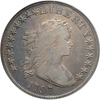 |
1797 Draped Bust $1 B-3, BB-71. Rarity 2. PCGS graded Fine-15. Nice even toning. The strike of this specimen is excellent, with the features in all areas visible in either outline or detailed form depending on the areas of circulation wear, the eagle, too, is very presentable. Light to medium silvery gray, smooth fields with choice, mark-free rims. This is the kind of quality a Type collector is looking for. Pop 1; 8 finer (PCGS # 40004) .
Estimated Value $2,800 - 3,000.
Ex: Hesselgesser Collection.
View details and enlarged photos
Check results on similar lots
| Realized
$3,220 |
Lot 1060 |
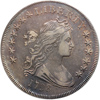 |
1798. Small eagle, 13 stars on obverse. B-1, BB-82. Rarity 3. PCGS graded EF-45. A small rim bruise above the second S of STATES. Characteristic die cracks through some of the reverse legends. Elusive and quite costly in About Uncirculated or better grades, this just-miss example in EF45 condition is free of noticeable surface abrasions. The strike, which is just about complete on all but the eagle, is well above par for a Draped Bust, Small Eagle silver dollar and both sides reveal variegated gray to russet-gray toning, with a deeper gray stripe diagonally across the reverse.
The year 1798 saw the number of obverse stars decreased from 16 (used in 1797) to 13, the number that remained in effect throughout the remainder of the series. An exception is provided by 1798 BB-81, with 15 stars, an anachronism created by using a leftover undated die prepared in 1795 or early 1796 (before the 16-star format became standard following the admission of Tennessee to the Union), and dating it 1798.
Two reverse designs were employed: the older Small Eagle type (1798 BB-81 and BB-82) and the new Heraldic Eagle motif (all other 1798 varieties BB-91 to BB-125). The vast majority of 1798 dollars minted were of the Heraldic Eagle type.
As the obverses for BB-81 and BB-82 (which have old-style Small Eagle reverses) were made early in the year, and as these each have a knob to the bottom of the 9 in the date (Knob 9), it is presumed that the with-knob numeral style was also used earlier in the year for obverse dies that were mated with Heraldic Eagle reverses. Conversely, the Pointed Tail 9 issue dies are believed to have been made later.
As a date, 1798 Small Eagle dollars are fairly scarce and actively sought by buyers of all stripes. Examples are encountered in all lower grades, although those in Extremely Fine, About Uncirculated and Mint State must be deemed rare (PCGS # 40006) .
Estimated Value $12,000 - 13,000.
Ex; Hesselgesser Collection.
View details and enlarged photos
Check results on similar lots
| Unsold |
Lot 1061 |
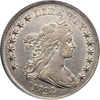 |
1798 Draped Bust $1 B-25, BB-123. Rarity 4. PCGS graded AU-53. An choice light-silver colored coin with luster in all protected areas. The satiny frost nice to see while the strike is sharp or nearly so, and the eye appeal is nothing short of exceptional. Problem-free rims and fields throughout.
Close date with a "whisker" on the chin. Die dot in the field under chin, about one-third of the distance between neck and star 12. 1 in date very close to curl. Last star near bust, upper right star distant from Y, upper left star still farther from L, and first star farthest from curl. This obverse die used to strike 1798 BB-123 only. Extensive die breaks on the obverse.
BB-123 has the familiar "Blundered Stars Reverse" with blundered star placement; some stars overlap clouds. Perhaps, the engraver had too his eyes crossed while cutting this die! Pop 1; 1 finer in 55. Only 3 examples graded for the variety at PCGS. (PCGS # 40040) .
Estimated Value $10,000 - 11,000.
Ex; Hesselgesser Collection.
View details and enlarged photos
Check results on similar lots
| Unsold |
Lot 1062 |
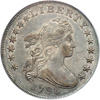 |
1798 Draped Bust $1 B-22, BB-104 Wide Date. Rarity 4. PCGS graded AU-53. A worthwhile Bust Dollar by any standard, the luster at the devices is not in the least timid or yielding, while pale gray and other toning highlights blossom on both sides. The strike, like the luster, is confident, indeed, as bold as ever seen on virtually any example of the variety. The dentils on the reverse somewhat wider along the left side than the right.
1798 BB-104 is in the middle range of availability among dollar varieties of this date. Several hundred are believed to exist, an estimated 225 to 400. Most are in lower grade ranges, however, but AU coins exist in strictly limited numbers, per the population figures, meaning that another opportunity like this will occur only every few years on the auction market, and perhaps even less often privately. Above EF, specimens are very rare. The variety may have no more than one known in Mint State. Pop 1; 1 finer in 61. Only 2 examples graded for the variety at PCGS. (PCGS # 40021) .
Estimated Value $9,000 - 11,000.
Ex; Hesselgesser Collection.
View details and enlarged photos
Check results on similar lots
| Unsold |
Lot 1063 |
 |
1798 Draped Bust $1 B-20, BB-102. Rarity 5. PCGS graded EF-45. Sleek mid-level gray which has grand overall eye appeal; the highest points of the design show lighter silvery gray color. The above-average strike on Liberty complements this eye-appeal and, some might say, adds immeasurably to the appearance. Typical for the variety, portions of the central reverse are lightly struck. A noticeable die cut (late-stage die break) occurs below the eagle's tail, clearly visible in the photograph. Rare in this grade: Pop 1; 1 finer in 50. Only 3 examples graded for the variety at PCGS. (PCGS # 40019) .
Estimated Value $7,000 - 8,000.
Ex; Miller/Hesselgesser Collection.
View details and enlarged photos
Check results on similar lots
| Unsold |
Lot 1064 |
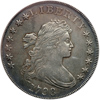 |
1798 Draped Bust $1 B-15, BB-112. Rarity 3. PCGS graded AU-50. An problem-free and well toned examples whose clean-surfaced beauty comes with adequately defined design features on Liberty but with the usual softness in the strike on the eagle and in the stars above due to insufficient metal flowing into the dies. Rims are outstanding. The surface, free from marks or impurities of any kind.
It appears that several hundred specimens of 1798 BB-112 exist, probably about 250 to 450, according to the Bowers reference, placing it in the medium range of rarity among varieties of this date. Most specimens are in grades up through VF and EF. AU or finer pieces are very rare. Pop 1; 1 finer in 58. Only 5 examples graded fir the variety at PCGS (PCGS # 40029) .
The obverse of this variety has a wide date, 11 mm. across at bottom widest part. 7th star very close to L, slightly closer than figure 1 of date from curl. Last star slightly nearer bust than figure 8 is from bust. Lowest right star ray points to a space between two denticles. The L and I in LIBERTY are distant while a spike protrudes from the hair below the point of the upper curl. Interior of lower curl is shaded. On the left, space between stars 5 and 6 is greater than between other stars. On the right, star 13 is smaller than any others. This obverse die used to strike 1798 BB-112 only.
Estimated Value $7,000 - 8,000.
Ex; Hesselgesser Collection.
View details and enlarged photos
Check results on similar lots
| Unsold |
Lot 1065 |
 |
1798 Draped Bust $1 B-17, BB-101 5 Lines. Rarity 5. PCGS graded VF-35. Small rim cud (die break) above the O of OF. An choice example in all respects, the color is lightest around the stars, legends and devices as silvery halos with mid-levels of gray highlight the fields and devices on both sides. The strike isn't bold but neither is it weak, indeed, as bold as ever seen on this scarce and underrated variety. Pop 1; 1 finer in 53. Only 2 examples graded for the variety at PCGS. (PCGS # 40017) .
Wide date, the 8 just touching bust. Date is over 11.5 mm. across at bottom widest part. Upper star on left very close to L, and upper star on right is near Y. Second star ray points slightly right of denticle. The denticles to left of date are irregular. Obverse die used to strike 1798 BB-101 only. Reverse F: Large Letters reverse, 5 lines in each vertical shield element. BB-101 is from an later state. On the BB-101 variety some berries appear without stems. Only 10 arrows, the two sticks seen on BB-96 having now been removed. The reverse die was used to coin BB-96 dollars, reground and used to coin BB-101 Die State I dollars.
1798 BB-101 is a rare variety. Probably about 70 to 120 are known, most of which are well circulated. The average grade of Fine is one of just a few to dip below the VF category.
Estimated Value $6,000 - 7,000.
Ex; Hesselgesser Collection.
View details and enlarged photos
Check results on similar lots
| Unsold |
Lot 1066 |
 |
1798 Draped Bust $1 B-30, BB-116. Rarity 5. PCGS graded EF-40. 1798 BB-116 is one of the scarcer varieties of the year. Partly this was caused by extensive die cracks which could only have shortened the life of the dies, notice the most visible break below and thorugh the date, a diagnostic of this intriguing variety. Low population, high Condition Census: Pop 1; 2 finer in 50. Only 3 examples graded for the variety at PCGS. (PCGS # 40033) .
Reverse N used on BB-116 only: The upper stars on reverse are all very distant from the clouds. A leaf points to space between R and I in AMERICA. Arc star pattern. The point of the star barely touches upper part of eagle's beak (only three arc-pattern reverse dies, those used to coin BB-116, BB-117, and BB-125 have the ray at beak); the ray of the star points to upper outside right of B in PLURIBUS, while another ray points to the I. 13 arrows, two being faint. Five small berries, two at top nearest together.
Estimated Value $6,000 - 7,000.
Ex; Hesselgesser/Queller Collection.
View details and enlarged photos
Check results on similar lots
| Unsold |
Lot 1067 |
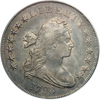 |
1798 Draped Bust $1 B-11, BB-111. Rarity 3. PCGS graded EF-40. Small edge bruise on the reverse above the second S. An very lightly toned and lustrous About Uncirculated that you can use as a benchmark for other examples of the Type that share this grade. While the strike is forthright and crisp, it is only reasonably full on some of the shield lines and central curls, yet without doubt few of the other head and drapery details are left to the imagination.
1798 BB-111 lies in the medium range of scarcity among dollars of this date. An estimated 250 to 450 exist. A perusal of auction data by the compiler of the Bowers encyclopedia found that VF is a high grade for this issue, and that an EF specimen is noteworthy. The average grade of F-19 is one of the lower figures among 1798 silver dollars. This issue circulated extensively, it seems. "Does even a full AU coin exist?" asks Bowers in his encyclopedia. Pop 1; None finer at PCGS. Only 2 examples graded for the variety at PCGS. (PCGS # 40028) .
Estimated Value $5,000 - 6,000.
Ex; Hesselgesser Collection.
View details and enlarged photos
Check results on similar lots
| Unsold |
Lot 1068 |
 |
1798 Draped Bust $1 B-27, BB-113. Rarity 2. PCGS graded EF-45. The holder is mislabeled. Close date, the 8 much too high, and out of position, top leaning to right. Identifiable by the presence of a tiny horizontal obverse die flaw at the inner point of star 12. On the reverse, a light die crack extends above S, through tops of OF, right wing tip, to border above first A in AMERICA. The 1798 BB-113 is of medium availability with an estimated that 500 to 800 in existence. Pop 2; 1 finer in 55. Only 4 examples graded for the variety at PCGS. (PCGS # 40030) .
Estimated Value $5,000 - 6,000.
Ex; Good River/Hesselgesser Collection.
View details and enlarged photos
Check results on similar lots
| Realized
$4,888 |
Lot 1069 |
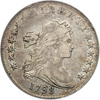 |
1798 Draped Bust $1 B-14, BB-122. Rarity 3. PCGS graded EF-45. One of two late die state examples in the Dr. Hesselgesser Collection, this being the finer of the two and solidly within the Condition Census to its high grade. An pleasing naturally toned example with clean surfaces beneath gently variegated toning. The reverse and obverse centers, while not 100% detailed, still play host to a lot of design originality that is always appreciated by the stronger buyers. In short, a choice coin, one that certainly meets the qualifications for the grade. Pop 2; 1 finer in 55. Only 5 examples graded for the variety at PCGS. (PCGS # 40039) .
Estimated Value $5,000 - 6,000.
Ex; Hesselgesser Collection.
View details and enlarged photos
Check results on similar lots
| Unsold |
Lot 1070 |
 |
1798 Draped Bust $1 B-24, BB-124. Rarity 2. PCGS graded EF-40. A smooth beauty, carefully handled so as not to damage the delicate features nor to mar the wide expanse of open field surrounding the devices. Level, rolling light gray patina with splashes deeper gray around devices accenting them. Pop 3; 3 finer; 1 in 45; 2 in 55. Only 6 examples graded for the variety at PCGS. (PCGS # 40041) .
Estimated Value $4,000 - 5,000.
Ex; Hesselgesser Collection.
View details and enlarged photos
Check results on similar lots
| Unsold |
Lot 1071 |
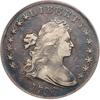 |
1798 Draped Bust $1 B-15, BB-112. Rarity 3. PCGS graded VF-35. Another example, toned deepest in the fields then offset by lighter silvery gray high points. Pop 1; 4 finer; 1 in 40; 1 in 45; 1 in 50; 1 in 58. Only 5 examples graded for the variety at PCGS. (PCGS # 40029) .
Estimated Value $3,000 - 3,500.
Ex; Hesselgesser Collection.
View details and enlarged photos
Check results on similar lots
| Unsold |
Lot 1072 |
 |
1798 Draped Bust Dollar. Large eagle. . BB-108, B-13. NCS graded Details of Extremely Fine harshley cleaned. Although it has been cleaned, the coin has a certain attractiveness to it all the same, mostly from the absence of heavy marks and circulation dings on the edges (of which there are none seen). A few stray adjustment lines through the hair at center. Reverse die used to strike BB-107 (earlier state) and 1798 BB-108 (later state, lightly relapped). 1798 BB-108 is one of the commoner varieties of the year, of which perhaps 500 to 800 survive according to Bowers (1993).
Estimated Value $1,000 - 1,100.
View details and enlarged photos
| Realized
$2,070 |
Lot 1073 |
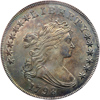 |
1798 Draped Bust $1 B-21, BB-107 Point 9 10 Arrows. Rarity 5. NGC graded AU-58. For the date, a lustrous, smooth-surfaced pale golden to antique gray beauty with a dash of cartwheel effect around the periphery on both sides. Attractively struck as well, with just a hint of softness at the eagle's head and breast feathers along with portions of E PLURIBUS UNUM on the scroll. Rims are outstanding. The surfaces, as mentioned, exceedingly choice for the grade, the age, and the Type. Worth considering.
Possibly incomplete reverse: Only 10 arrows plus a stick (headless arrow) between the 2nd and 3rd shafts from the right. Five small berries, two top ones closest together. Point of leaf under left lower tip of I in AMERICA. Star distant from eagle's beak. Arc star pattern. This is an earlier State before a die crack develops along the right wing tip, top of AM to border above E. Reverse die used to strike BB-107 (earlier state) and 1798 BB-108 (later state, lightly relapped). Pop 1; 1 finer in MS61. Only 17 examples graded for this variety at NGC.
Estimated Value $15,000 - 16,000.
Ex; Hesselgesser Collection.
View details and enlarged photos
| Realized
$14,375 |
Lot 1074 |
 |
1798 Draped Bust $1 B-14, BB-122 Point 9, Wide Date. Rarity 3. NGC graded VF-25. Die failure almost complete on this late state example: Die State VII: Bolender-14b. With same die cracks as State VI, the die crack on the obverse is now heavier, nearly obliterating star 7 and part of L. Bolender mentions a crack on reverse through right part of O(F), seen here. Rare. Only 25 examples graded for the variety at NGC.
Estimated Value $2,500 - 2,750.
Ex; Hesselgesser Collection.
View details and enlarged photos
| Unsold |
Lot 1075 |
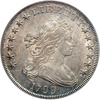 |
1799 Draped Bust $1 B-21, BB-169. Rarity 3. PCGS graded AU-58. Dancing cartwheel luster careens off the satiny, matte-like surfaces of this attractively toned AU58 with extensive areas of mint frost remaining. Not only does the luster adhere within the main devices on both sides, but it extends across the fields. The only touch of friction seems to be on the highest points of the design. As to the design itself, everything is bold here, indeed outstanding for the variety. A blend of toning shades can be seen on both sides. A genuinely handsome Draped Bust, Heraldic Eagle silver dollar. Pop 2; none finer at PCGS for the variety. (PCGS # 40060) .
Die notes: This is the only use of Obverse 11 (per the Bowers numbering scheme): Star 8 much closer to Y than star 1 to curl, or star 7 to L, or star 13 to bust. Star 1 is farthest from hair. In date, numeral 1 is close to curl. Slight die roughness below first star, between milling and curl. The second star on the obverse is repunched and the obverse shows die rust which becomes extensive on the late die state. The obverse is similar in appearance to BB-154 and BB-155; identification is simplified by the reverse which reuses the 1799 BB-167 die.
Estimated Value $17,000 - 18,000.
Ex; Hesselgesser/Queller Collection.
View details and enlarged photos
Check results on similar lots
| Unsold |
Lot 1076 |
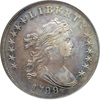 |
1799/8 Draped Bust $1 B-2, BB-143 13 Stars. Rarity 4. PCGS graded AU-55. A very attractive high-grade About Uncirculated with swirling light to medium gray colors that burst out atop the bright and hard-working surface beneath. Some weak spots in strike are usually seen on these, but the present example is at the very least bolder than 95% of surviving numbers. Note especially the smooth, clean fields and devices of the reverse. Pop 2; none finer at PCGS for the variety. (PCGS # 40066) .
1799/8 BB-143 is the scarcest of the three overdate die varieties of the year. I believe that 250 to 450 of this variety exist. This estimate, if accurate, makes BB-143 at least twice as elusive as BB-142 and about three times harder to find than BB-141. Equally important, unlike BB-142, the 1799/8 BB-143 variety is usually seen in lower grades, which is most important to the successful bidder of this attractive About Uncirculated 55 specimen.
Estimated Value $14,000 - 15,000.
Ex; Thaler/Hesselgesser Collection.
View details and enlarged photos
Check results on similar lots
| Unsold |
Lot 1077 |
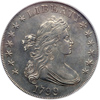 |
1799 Draped Bust $1 B-10, BB-163. Rarity 2. PCGS graded AU-55. A sleek and smooth well struck About Uncirculated with a gradation of medium to slightly more than medium neutral gray color on both sides. The contact from the dies is virtually complete, and very impressive here, lacking completely the usual hints of weakness seen on others of this variety. No doubt selected by the consignor for its superabundance of eye-appeal. Pop 3; 2 finer in 58. Only 8 examples graded for the variety at PCGS (PCGS # 40054) .
Estimated Value $14,000 - 15,000.
Ex; Hesselgesser Collection.
View details and enlarged photos
Check results on similar lots
| Unsold |
Lot 1078 |
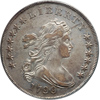 |
1799/8 Draped Bust $1 B-1, BB-142 13 Stars. Rarity 4. PCGS graded AU-50. A glossy high-grade coin and a lustrous one by any benchmark with residual dullish gray luster in and around the main devices. What's more, this has an engaging display of pale silvery iridescence that overlays the choice fields of what everone agrees is a desirable Redbook overdate, the first overdate in the Bust Dollar series. The strike is strong for the date, with just a touch of weakness on portions of the word PLURIBUS. Pop 1; 2 finer in 62. Only 5 examples graded for the variety at PCGS. (PCGS # 40065) .
Die State III: Die flaws advanced at I of AMERICA; die cracked at ATES OF, wing to ribbon, and at AME. Crack from denticles to left side of O, on to junction of clouds 6 and 7. Cracks around much of the border; die shattered.
Estimated Value $7,000 - 8,000.
Ex; Hesselgesser Collection.
View details and enlarged photos
Check results on similar lots
| Unsold |
Lot 1079 |
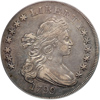 |
1799 Draped Bust $1 B-13, BB-151 Irreg Date. Rarity 5. PCGS graded EF-45. A thin pin scracht below the I in UNITED, another near the first star on the obverse. A few light marks elsehwere. Otherwise choice original surfaces with variegated shades of toning, mainly in the mid-level shade but a few patches of darker gray on the reverse. Pop 1; None finer at PCGS for the variety. (PCGS # 40044) .
Irregular date, per traditional nomenclature, although the "irregular" feature is more notable in the telling than in the seeing. Both 9s are improperly placed, the first is tipped too far to left at top, the last 9 too far to right at top. It has been suggested by Walter H. Breen that a Draped Bust obverse die was made in 1798, but with date incomplete and as 179 only; later to be finished by adding another 9 in 1799. A ray of star 13 touches bust. On the left, stars 3 and 4 are wider apart than are any others. On the right, stars 10-11 are closer together than are any others. Perfect die without cracks. Obverse die used three times to strike 1799 BB-151 (first use), BB-152 (intermediate use), and BB-153 (final use).
Estimated Value $7,000 - 8,000.
Ex; Miller/Hesselgesser Collection.
View details and enlarged photos
Check results on similar lots
| Unsold |
Lot 1080 |
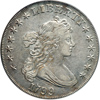 |
1799 Draped Bust $1 B-10, BB-163. Rarity 2. PCGS graded AU-50. Smooth light silvery color permeates this surface with a natural beauty all of its own. Add a decent level of detail on Liberty's hair waves and the eagle's features and the appeal is very tempting. Numerous reverse die cracks are noted on BB-163. Pop 1; 5 finer; 3 in 55; 2 in 58. Only 8 examples graded for the variety at PCGS. (PCGS # 40054) .
Estimated Value $7,000 - 8,000.
Ex; Hesselgesser Collection.
View details and enlarged photos
Check results on similar lots
| Unsold |
Lot 1081 |
 |
1799 Draped Bust $1 B-18, BB-154. Rarity 5. PCGS graded EF-45. A carefully preserved Bust Dollar of this scarce variety with strong fundamentals including clear, undamaged rims and fields (only a single shallow mark on the neck), exceptional hair and eagle definition, and featuring the defining die break that may have shortened the life of the die. A crack is clearly seen from the rim crossing between ED of UNITED on the reverse, to the eagle's wing. Nicely struck, therefore, more totally than many 1799-dated silver dollars. The toning drifts ever so slightly between medium "old silver" hues to deeper steel and pewter gray shades.
1799 BB-154 is the second rarest die variety of 1799, according to the Bowers encyclopedia, "and is exceeded only by BB-151. I estimate that only 60 to 100 are known. Nearly all of these are in well-worn grades. A few coins described as Uncirculated came on the market years ago, but it is probable that most would grade less today." This BB-154 is an ideal example of a coin that the precision-minded buyer is looking for. Importantly, check out these numbers: Pop 1; 2 finer in 55. Only 3 examples graded for the variety at PCGS. (PCGS # 40046) .
Estimated Value $6,000 - 7,000.
Ex; Hesselgesser Collection.
View details and enlarged photos
Check results on similar lots
| Unsold |
Lot 1082 |
 |
1799 Draped Bust $1 B-19, BB-155. PCGS graded AU-50. A lock-solid About Uncirculated specimen with strong primary luster adhering around some of the devices and rich toned surfaces on both sides. More than adequately struck for the 1799 issue, though perhaps not 100% so, since this variety rarely is at the centers, but certainly a coin that gets credit where fullness of design is concerned (PCGS # 40047) .
This variety marries an obverse used earlier on BB-154 to a reverse from the 1799/8 BB-143. Has the same crack through D in UNITED as seen on BB-143. Far right edge of A is over junction of clouds 3 and 4. "Reverse stars always weakly impressed" explains the Bowers encyclopedia.
Estimated Value $6,000 - 6,500.
Ex: Hesselgesser Collection.
View details and enlarged photos
Check results on similar lots
| Unsold |
Lot 1083 |
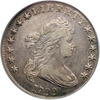 |
1799 Draped Bust $1 B-8, BB-165. Rarity 3. PCGS graded EF-45. A worldly measure of natural shades of "old silver" gray improves the attractiveness of the wide expanse of open field on both sides. The fields are only lightly abraded for the grade, while the main devices show some wear on the topmost hair curls, cheek, and shoulder areas of the bust, portions of PLURIBUS (which is weak) and the eagle's head and wing tops. The reverse is noted for a die break through some of the upper letters in STATES OF. Pop 1; 1 finer in 53. Only 3 examples graded for the variety at PCGS (PCGS # 40056) .
Estimated Value $5,000 - 6,000.
Ex; Hesselgesser Collection.
View details and enlarged photos
Check results on similar lots
| Unsold |
Lot 1084 |
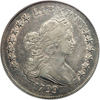 |
1799 Draped Bust $1 B-15, BB-152 Irreg Date. Rarity 3. PCGS graded EF-40. Initial traces of luster can be found at the stars and within the reverse letters of the legend, matte-like neutral-gray surfaces of this attractively original specimen. A blend of lighter gray graces the high points on both sides. The strike is somewhat soft in areas of the hair but less so on the reverse, where the design elements such as E PLURIBUS UNUM and the shield lines are complete. Pop 1; 2 finer; 1 in 50; 1 in 64. Only 4 examples graded for the variety at PCGS. (PCGS # 40045) .
Estimated Value $4,000 - 5,000.
Ex; Hesselgesser Collection.
View details and enlarged photos
Check results on similar lots
| Unsold |
|
|